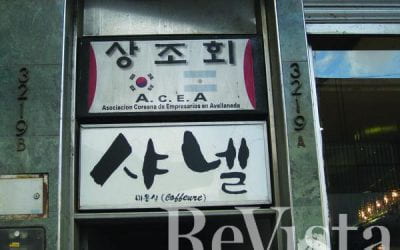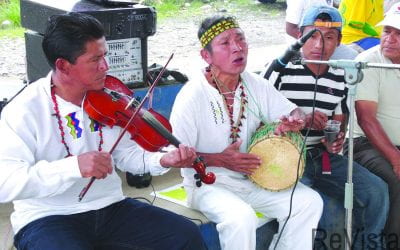Nikkei Latin America
Japanese people and their descendants have been part of the Latin American ethnoscape for more than a hundred years. People of Japanese descent whose “home” countries are elsewhere than Japan, are called Nikkeijin (people in a Japanese descent line) or more simply (and often more commonly in the Americas) Nikkei. Latin America has been particularly important in showing how networking among Japanese descent groups brought about a global identity of such people as Nikkei, and awareness of being part of a Japanese diaspora, a consciousness emerging in the last 20 to 30 years despite the long existence of such groups in various countries.
An examination of Japanese descent communities in Latin American countries and their on-going ties with Japan sheds light on how people establish identities weaving together a sense of ancestral heritage with attachments to the societies in which they live, while showing both convergence and divergence from ideas, concepts and values of their ancestral places. Such research also sheds light on other current issues, ranging from radiation effects to immigration.
Ways in which Latin American countries were brought into the historic internment of people of Japanese descent during World War II, often little known about even in the United States where Latin American Nikkei were interned along with Japanese Americans, can help inform contemporary issues related to borders and concentrating people into encampment areas, including Latin American children separated from family members, into encampment areas (see Mary Jo McConahay’s story on p. 25). Nikkei communities in Latin America also provide important insights to on-going effects on people and their descendants as a result of exposure to radiation from the atomic bombings of Japan at a time when some officials in countries such as the United States would like to increase nuclear arms, reversing long-term struggles to reduce the numbers of such weapons in the world.
Japanese immigrants began coming to Latin America in the late 1800s when this became possible after Japan was forced to lift its long policy (since the 1600s) of maintaining a ‘closed country’ (sakoku) under whose terms non-Japanese could not enter Japan for the most part and Japanese could not leave it (except upon receiving punishment of a death sentence). Once it was possible for Japanese to pursue movement abroad, they did so, and immigration to the Americas began. Many went to the United States and Canada, and many to Latin American countries. While immigration is on-going, three periods of immigration to Latin America from Japan are particularly pertinent; early immigration to Latin America from the late 1800s on; increased immigration to Latin America from the 1920s because of U.S. desire to limit or eliminate immigration from Asia done under the so-called gentleman’s agreement resulting in potential immigration to the United States being diverted to Latin American countries; and a migrant wave following World War II, when many Japanese emigrated to Latin America after the overwhelming destruction of Japan during the war. The earlier attempts to block immigration from Asian countries have later been condemned as discriminatory processes against particular peoples and countries of the world, shedding potential light on current attempts to restrict immigration from certain Arab countries.
Brazil became home to the largest number of people of Japanese descent in the world outside Japan. São Paulo became home to many Japanese Brazilians, with the Liberdade area becoming a bustling Nikkei center area that still retains a concentration of Japanese stores, restaurants, other businesses, and community groups. Japanese immigrants also settled in Registro, near São Paulo but removed from the urban core, where Japanese immigrants set up tea plantations with tea plants and seeds brought from Japan, and also processed the harvested tea leaves there. A heritage area to the history of Japanese immigration to Registro is maintained there, including heritage buildings that housed workers and factories that processed tea.
While Brazil has the largest number of persons of Japanese descent, their presence is marked in many Latin American countries where it reveals similarities and diversities in their histories and contemporary existence as ethnic communities of Latin America. Mexico has an old, long-standing community established over 120 years ago, which celebrates its long presence in Mexico and takes pride in its dual tradition. Argentina and Chile may have smaller such communities, but they are ones that have been active in recent decades, with many youth re-exploring their identities as members of Latin American countries with a sense of Japanese ancestry. Many Japanese immigrated to Bolivia after the World War II period. There Nikkei have been less integrated; they remain in residential enclaves such as the so-called “Okinawan colonies” or those residential agricultural communities largely comprised of people who immigrated from Nagasaki. Many had been farmers in Japan (the most common occupation at the time) and settled in such communities (sometimes called “colonies”) to collectively restart agricultural activities in Bolivia. Peru has a large and prominent community of Nikkei. Peru also had a Nikkei president, Alberto Fujimori. Initially having a person of Japanese descent reach the top post of the country and become the president was a point of pride for Japanese Peruvians, but unfortunately the president was later disgraced. Noteworthy, however, is that his rise to popularity and the presidency was in part thought to be related to his ability to merge values from the agrarian background of Japan that resonated with rural voters in Peru.
Colombia, as some other Latin American countries, has active hibakusha members. Hibakusha is a term for surviving victims of the atomic bombings or atomic testing elsewhere in the world. Latin American Nikkei communities have been important in understanding the long-term nature of atomic radiation poisoning in human beings. Many of the agreements to deal with medical issues of survivors involved Japan and the United States, at a time when later effects of exposure to radiation poisoning were not well known. Thus, among immigrants to Latin America were some who were seemingly healthy despite exposure to the atomic bombings but who later developed cancers and other medical problems in higher numbers than expected in a general population due to exposure. While similar cases occurred in Japan, immigrants to other countries, such as those in Latin America, had additional problems because they were not residents of the countries involved in the initial medical treatment agreements (based on the idea that survivors lived in Japan or were returned U.S. servicepeople) and thus had to band together for recognition of their cause. Issues also occurred over birth defects or medical problems in subsequent generations and establishing the connection to radiation exposure of parents or grandparents. Thus, like Bolivia which had a high number of settlers from Nagasaki due to relocation after the destruction of the atomic bombing, other Latin American hibakushareveal that issues related to war and use of nuclear weapons did not end with the war, but need to be dealt with among survivors for decades and generations, and in areas of the world far removed from the original blasts.
Latin American countries were particularly important in the rise of an internationalized ethnic identity of being Nikkei or someone of Japanese descent anywhere in the world along with the recognition and greater understanding of the existence of a Japanese diaspora. Even until the late 20th century, Japan was not thought to have a diaspora like many other countries including those from Asia such as China. Scholars would often give reasons for the lack of a Japanese diaspora, such as so-called cultural attitudes against emigrating. Yet, Japanese individuals began moving and immigrating abroad as soon as this was possible and by the late 1800s. What was absent was not a Japanese diaspora but a common identity that linked people of Japanese descent in diverse countries of the world. Then in the late 20th century new organizations such as the Pan American Nikkei Association (PANA) facilitated gatherings and networking of Nikkei from throughout the Americas, meeting alternately in a North American (including Mexico) and South American venue. People from Latin American countries in particular came together to share their immigrant histories and discuss their shared issues, developing a consciousness of being Nikkei and of being part of a Japanese diaspora, which is now also well recognized in scholarship on or related to Japan and Japanese descent groups.
Ongoing and renewed ties among Latin American countries and Japan are important in showing how people perceive their own identities and build on understandings of their heritage or ethnic backgrounds along with their presence, participation and identities as members of the countries in which they reside and/or have citizenship. Particularly from the 1990s Japan—needing additional workers but not wishing to open fully to immigration from outside—developed programs and laws to allow Nikkei elsewhere to come to Japan as the country of their ancestral heritage, live and work there. Most of those who did so came from Latin American countries. While most of these were Japanese Brazilians, many Japanese descendants from Peru, Mexico and Chile, among others,also went to Japan to reside (often for many years) and work. As a result, those within Japan learned that being of Japanese descent from abroad was not the same as being Japanese in Japan. These Latin American Nikkei developed a stronger sense of their identity with the Latin American country they came from living in Japan, as they realized they identified more strongly with their “home” country in which they had been born and raised than with their ancestral country of Japan, something many were not aware of until they resided in Japan. Thus, the histories of Japanese immigrants to Latin America, their diverse communities in different areas of Latin America, and their greater understandings of their own identities as members of Latin American countries—while also grasping and maintaining a sense of Japanese ancestral or heritage identity—reveal much about human international and transnational flows, adaptation and identity-building along with the ability to construct diverse human societies and collective national identities that allow for or embrace multiple understandings of identity formation.
Fall 2018, Volume XVIII, Number 1
Millie Creighton is a Japan specialist and Associate Professor in the Department of Anthropology at the University of British Columbia in Vancouver, Canada. She has done extensive research on a range of topics within Japan and also on Japanese descent groups in the Americas. Her publications related to Nikkei in Latin America include “Metaphors of Japaneseness and Negotiations of Nikkei Identity: The Transnational Networking of People of Japanese Descent,” pp. 133-162 in Japanese and Nikkei at Home and Abroad, ed. by Nobuko Adachi. (New York: Cambria Press 2010).
Related Articles
From Vendedor to Fashion Designer
English + Español
Korean immigrants in Latin America are shaping and developing fashion economies there. Upon arrival, Korean immigrants to Argentina and Brazil may have been lonely, isolated and confused…
Shared Sentiments Inspire New Cultural Centers
English + Español
In the early afternoon of January 3, 2018, in the mountainous village of Shicang, Zhejiang Province, China, firecrackers burst into the air and flags waved in the wind as a parade of Clan…
Evidence for Hope: Making Human Rights Work in the 21st Century
A Review of Evidence for Hope: Making Human Rights Work in the 21st Century Contemporary Human Rights and Latin America On September 5, 1921, Roscoe “Fatty” Arbuckle, Hollywood’s then best-paid star, attended a party in San Francisco’s St. Francis Hotel, drank...








